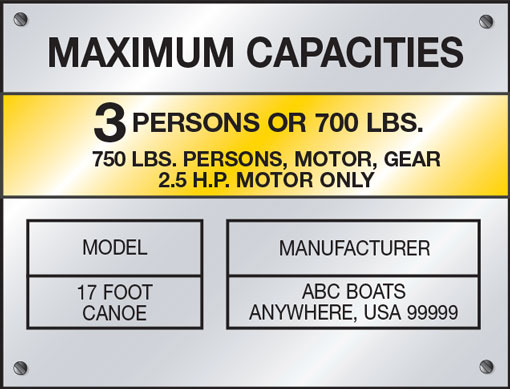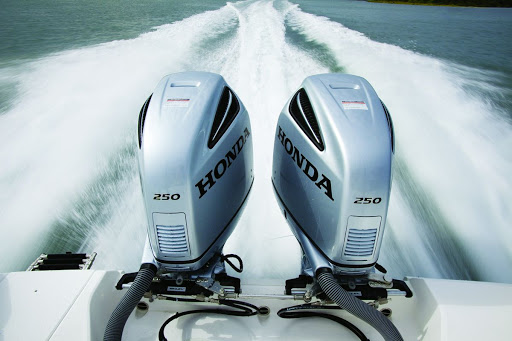Owning a vehicle with an outboard motor comes with certain responsibilities. Outboard motors offer numerous benefits, including full portability and easier maintenance. Another thing to note is that an outboard motor comes with a lower price tag making it a good choice for people trying to save money.
In addition to this, an outboard motor provides a higher top speed than alternatives. With that being said, you’ll want to know more about the horsepower rating of your outboard motor.
On these motors, there is a good chance that it is going to contain a capacity plate with a horsepower rating. You’ll want to use this to your benefit. More about this rating can be found below.
Where Is The Capacity Plate?

You’ll need to know where to find the capacity plate. Remember that its location may vary depending on the model you’re working with. However, it is generally located near the operator’s position. It could also be located on the transom.
The plate is very important because it tells you more about the boat and its operation. You’ll want to refer to this information before hitting the water. Otherwise, you may overload the boat and experience additional problems.
- What Does It Mean?
As mentioned above, it is a good idea to check the capacity plate before moving forward. Otherwise, you might get yourself into trouble. The capacity plate tells you a lot about the boat’s capacity. As the name implies, it can tell you more about the boat’s weight capacity.
It’ll also help you determine how many people the boat can transport during good weather. It is pertinent to pay close attention to this information. Otherwise, you may overload the boat and create problems for yourself.
Use this information to properly load the boat. Never overload an outboard boat because doing so could be risky.
The Boat’s Capacity
Before loading your boat with people, it is pertinent to learn more about the boat’s capacity. Learning more about the boat’s capacity ensures that you can avoid potential problems.
The capacity plate will tell you certain information, including the maximum number of people you can carry, the maximum gross load, and the maximum horsepower. Many plates will also provide the boat’s model number, serial number, and the name of the manufacturer.
Just remember that some watercraft do not have capacity plates. If you’re operating a personal watercraft, it likely won’t have one. Therefore, you will need to find the recommended capacity in the owner’s manual. It may also be found on the warning decal. Either way, it is pertinent to pay close attention to this information so you can avoid problems when boating.
- Maximum People
Before operating a watercraft, it is vital to make sure that you haven’t overloaded it. If you have, you’re going to experience issues along the way. The risk for problems will be much higher. When calculation how many people can be on the boat, the manufacturer will believe that each person weighs 150 pounds.
With that being said, there is a risk that the number isn’t going to be 100% accurate. You’ll need to give or take a bit to find out what will work for your vessel.
If you’re going to be hauling heavy equipment, you’ll need to account for it.
- Maximum Horsepower
It is a good idea to learn more about the boat’s maximum horsepower. In many cases, this number can be found on the boat’s capacity plate.
However, it might not be. If you’re operating a flat-bottomed boat, you should be able to figure this out on your own. To determine the maximum horsepower, you’ll need to figure out the square footage first. You can figure this out by multiplying the length and width.
Then, you can use an online calculator to determine the boat’s maximum horsepower. If the boat is 4 foot wide and 12 foot long, its max horsepower will be 15.
If the square footage is between 46 and 52, the max HP will be 15 as well.
- Overpowering And Overloading
Ultimately, it is pertinent to pay close attention to the capacity label. Otherwise, there is a risk that you’re going to either overpower or overload the vessel. You’ll want to prevent this from happening because both can be extremely dangerous.
Having an oversized engine on the boat will cause it to sit too long near the stern. As a result, this will increase the likelihood that the boat is going to get swamped by a wake. Another thing to note is that an overpowered boat will be difficult to control.
Overloading your boat is equally dangerous. If you have too many people on your boat, there is a chance that you’re going to experience swamping as well. You also need to worry about loading the boat with too many supplies.
When loading a boat, it is pertinent to evenly distribute the weight. It is best to keep most of the weight in the center of the boat. Doing so can help reduce the risk of capsizing and swamping.
Finally, you have to pay close attention to the weather. If it is going to be stormy, you need to be cautious about adding too much weight to the boat.
When dealing with higher waves, a heavier vessel will be more difficult to control. Therefore, it’ll be more likely to get swamped. You need to avoid these problems and stay safe. Doing so is the best way to enjoy yourself on the water.
Tips For Not Overloading Your Boat
At the end of the day, you need to go above and beyond to avoid overloading your boat. To do that, you need to start by checking the boat’s capacity. Be sure to check the capacity plate since it’ll tell you everything you need to know.
Once you’ve done that, you’ll want to begin loading the boat slowly and cautiously. Remember that the capacity plate will tell you the boat’s maximum passenger limit, maximum gross load, and maximum horsepower.
If you don’t have a capacity plate, you can figure it out on your own. Multiple the boat’s lengths by its weight. Then, you’ll want to divide that number by 15.
Always stay below the maximum weight capacity to avoid problems. Don’t forget that this includes your passengers and gear. You cannot overload the boat with people or gear. Doing so will create more problems.
Also, don’t take extra passengers. Adding too many people will cause the boat to become overloaded. You’ll also need to focus on evenly distributing the weight. You don’t want it to learn in one direction or the other. To prevent problems, make sure the weight is evenly spread across the boat. Do that to avoid potential issues while on the water.
Summary
When loading an outboard boat, it is pertinent to pay close attention to the capacity plate and its horsepower rating. You’ll also want to use this information to avoid overloading the boat. Be cautious and load the boat carefully. If you overload or overpower the boat, you’re going to experience severe problems.
Use the information above and what you’ve found on the capacity plate to protect your passengers, yourself, and your boat. Finally, don’t forget to evenly distribute the weight on the boat.
Read Also: A PWC Capsizes. What Is The Best Way To Roll The PWC To Turn It Upright?

Ever wondered how you can have a cruising boat without getting into financial problems? The answer is here. That is the reason why we set up this blog to share with you, safety tips, answers to questions that have to do with fishing and hunting. You are going to love it!
Hey! I am Armstrong!
